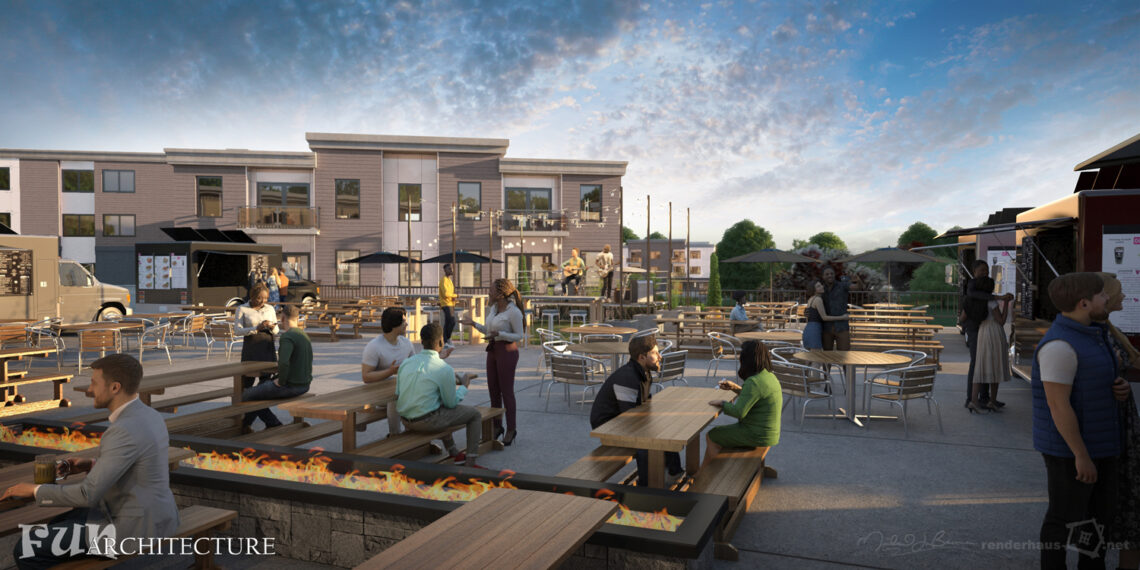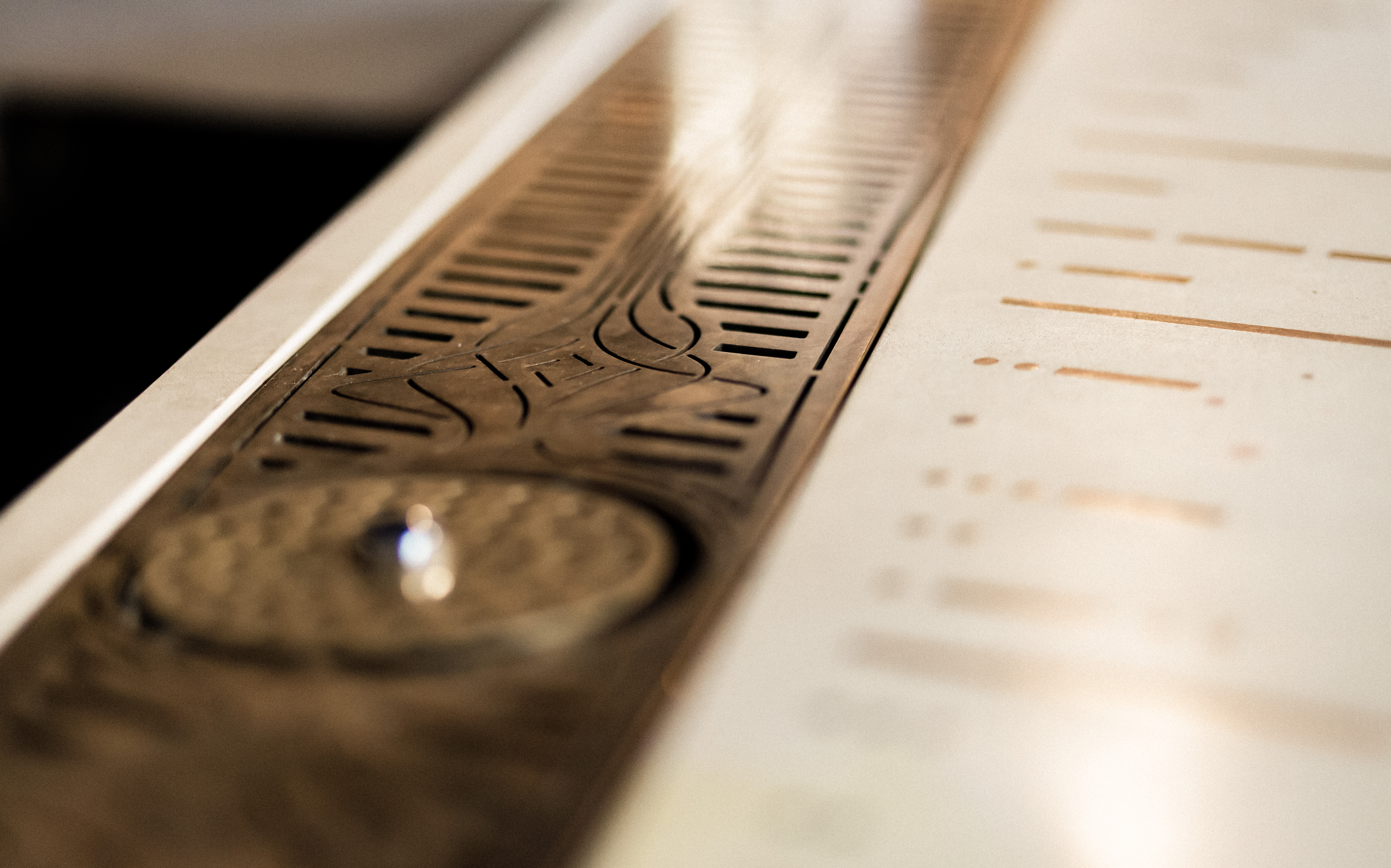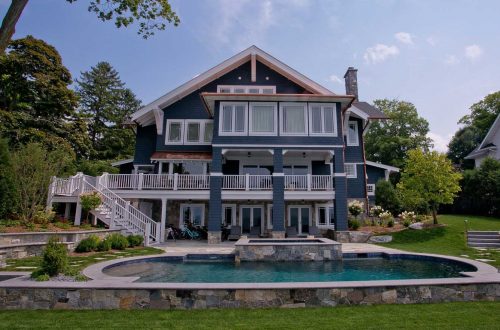Founding Principal, Owner
FUNchitecture LLC | Flint, Michigan
While considered simple in her own words, Shannon Easter White, owner and founding principal of FUNchitecture LLC of Flint, Michigan, is driven by an architectural philosophy that embraces an authenticity, a permanence, and an element of joy in both the process and the end result. Defined by a commitment to fun, it is a philosophy that goes beyond surface-level happiness to the depth and complexity inherent to human-centric design, where fostering purposeful spaces with longevity have the ability to enhance the pleasure of living and people’s lives while contributing to the overall architectural landscape.

“I feel my philosophy is really simple and really staying true to this whole idea that it is fun. Why am I doing this job if it is not fun? So, I’ve committed to making my job fun and I don’t take on projects that I don’t think are interesting or innovative or have a means to change somebody’s life for the better. I want my client to think designing is fun and I want the process to be fun for them,” Easter White said.
“What makes good design is how people feel in the space and how a space makes people feel, and ultimately that is a really simple answer, but if people love going to the place in which they must work whether that is at home, an office, a zoo, or in a factory, the space has to foster their happiness. It should be inspirational. Good design fosters creativity and more importantly, productivity.” Easter White added.
It is an outlook and an approach shaped not only by her parents’ creative- and technical-brained influence and formative years born and raised in Flint, but also from her time spent studying and honing her vocational skills abroad in Italy throughout her academic career. As a child, Easter White noted she and her siblings would often complete arts-and-crafts projects for her mother—who as an elementary classroom teacher took on a multifaceted role as gym, arts, and music educator within the Flint Community Schools District—and can recall her father at the drafting table coming up with design solutions as an engineer for General Motors.
“Three decades ago, the school district—like many public school districts—was in such a bad financial state that they laid off their specials teachers, which would be like gym, art, and music, and so my mom became the gym, art, and music teacher, in addition to her standard third grade classroom teaching duties. She’s very creative-brained and so my siblings and I were always the guinea pigs for the things she wanted to do with her class,” Easter White said.
“Then my dad, who was straight engineer, I grew up with him at the drafting table because for General Motors everything was hand-drafted at the table. Those two brains are very much embedded in who I am. I have this very wacky, creative side from my mom who was always very fashion forward and made her own clothes, and I have this very straight-forward, problem-solving brain from my dad,” Easter White added.
The combination, which lent itself well to the field of architecture, led her to pursue both drafting and art courses in secondary school and after attending Western Michigan University for two years, where she played collegiate-level soccer, she transferred to the University of Michigan’s Taubman College of Architecture and Urban Planning in Ann Arbor, Michigan to continue a formal training in architecture. Upon completing her undergraduate degree, Easter White said she took a year off to participate in the Rotary International Foundation’s Group Study Exchange Program. The nonprofit organization’s exchange program was created to offer a cultural and vocational opportunity for young professionals to learn and exchange ideas with other professionals in different countries.
“It was spectacular. I can’t say enough about the Group Study Exchange. You are living with host families you don’t know—they are Rotarians—and because it is a professional exchange, I was also there with someone who was in the newspaper business, I was there with a professional photographer, and so the photographer was with a professional photographer in Florence, for example, and I was with an architect in Venice, who was responsible for the restoration of San Marco Basilica,” Easter White said.
“It was a life-changing experience, simply incredible architecture that is thousands of years old and here is just a regular guy responsible for doing all of this restorative work. It was really inspirational,” Easter White added.
For Easter White, who spent about a month in Italy in regions like Venice, Florence—a UNESCO World Heritage Site—Bolzano, and into the Trentino-Alto Adige part of the Alps, the experience would be one that not only extended into another four-week tour of Europe backpacking with her sister, but also a return trip to Florence during her time enrolled at the University of Michigan’s graduate program in architecture. While training in the city, considered by many as the birthplace of the Renaissance, and spending time beneath fully frescoed ceilings of an old villa leased by the university, Easter White also noted she was able to visit a number of other destinations like Switzerland, London, Spain, and Ireland.
“It was unbelievable and I think it gave me a whole different perspective of the career profession that I had picked, because architecture in Europe is obviously is centuries older than it is in the United States and just the unbelievable craftsmanship and design sensibility and the longevity—timeless, timeless architecture that people flock to and tourists go to see specific buildings and specific cities—that was really influential for me as a young designer,” Easter White said.
Initially working at a firm during undergrad that has since become the woman-owned architecture and design practice known as INFORM Studio in Northville, Michigan, Easter White returned to her hometown of Flint after completing her graduate work to continue her professional career at THA Architects Engineers, a full-service architectural and engineering firm, for 10 years. Easter White then launched her own firm around 2009 and has since developed a portfolio of work rooted in practical design, creative solutions, and collaboration throughout the entire process.
“Ken and Gina Van Tine, and Michael Guthrie were more influential on me than they know,” said Easter White, in reference to her time spent at INFORM. “Then I worked at a firm for 10 years in my hometown in Flint, which was THA, and Jim Tomblinson, firm founder, then in his early 80s, was my mentor and he just really instilled in me the importance of trusting and lasting client relationships that can turn into lifelong friendships. He always led with a client-based, service-first, no-ego kind of philosophy that has carried with me.”
Throughout FUNchitecture’s 13-year-tenure, Easter White has built an award-winning portfolio specializing in commercial work. In 2013, the firm was recognized with Best Sustainable Design for its collaboration in the Urban Alternatives House with the University of Michigan-Flint and Genesee County Land Bank—and later would be recognized LEED Platinum by USGBC in 2014. The firm was also recognized in 2016 by AIA Flint and the American Planning Association, noting the Flint Farmers’ Market as one of the top five Great Places in America: Public Spaces. While Easter White noted she has done a few very innovative custom residential projects throughout the years—including her own home that she recently designed and built with her husband, who was also trained in architecture—she is drawn to commercial work, and the opportunity to reuse existing building stock while practicing in Mid-Michigan is a great opportunity.
“My design philosophy is always that something should be timeless. I love pop art and I love contemporary design, but I think statements of architecture must be lasting. In America, we have a very throw-away culture, which is sad, and I’ve done a lot of adaptive reuse projects in my life—I wouldn’t consider myself a historic preservationist by any means—but it is thrilling to make a building that had a different purpose seem fabulous and new,” Easter White said. “My office is in Flint, a city that had an amazing heyday and has had a lot of disrepair and abandonment and to put buildings into play that really could have been torn down is exciting.”
While Easter White recognizes there are a number of new challenges facing the industry, such as the climate crisis and the need to leverage innovative technology and be willing to try new things, there are also others that are not new, like communicating the value of good design and increasing the number of licensed architects coming out of architecture school.
“That has not changed, and we are not doing anything to improve licensure rates and I think part of the premise of a really good architect is simply this: that they are a brilliant and innovative problem-solver. And I think that brilliant and innovative problem-solvers can serve many purposes in the world. Architects don’t make that much money, to be honest, so it is much easier for an architect to jump ship and go to the construction side or the corporate facilities management side and make three times the salary,” Easter White said. “I also think part of it is that, especially Americans, people in general don’t value great design and so they don’t see the purpose and the value in having an architect.”
Despite it, Easter White envisions the future of architecture as bright, amazing, and innovative; inspired by a design framework and principled guideline where function, aesthetics, color, efficiency, permanence, and sustainability set a foundation for successful architecture.
“I was reading this [National Geographic] article about the three happiest places on Earth. Costa Rica, Denmark, and Singapore are where people identify as happiest, and I think these threads or strains of happiness are in pleasure, purpose, and pride. I think people who identify as the happiest live in countries where governments, holistic systems, and societal systems foster that. There is so much importance in building place that is meaningful and happy,” Easter White said. “It is important to me that place services purpose and brings a joy in being there—whether it’s for prayer or for play or work or fitness or recreation.”
Recently, Easter White noted she just completed an extensive new headquarters building for a local credit union that created a three-story building that leveraged the site’s steep topography to create a lower level “walk-out” complete with expanses of glass and doors from the staff café that offer views out onto a park and retention pond featuring landscaped wildflowers and a walking path. A lower-level dining patio has promoted lunchtime cook-outs, tailgate parties, and community events, and an upper floor patio has welcomed staff to enjoy happy hours after work to build camaraderie and build workplace friendships. Prior to this new facility, Easter White said employees who worked in the call center of the old headquarters were located in a windowless basement.
“We built them an almost all-glass building where they are overlooking a gorgeously manicured cemetery and they are overlooking a park that is part of Genesee County Parks and Recreation, and a beautiful campus and this gorgeous retention pond, and these people love going to work,” Easter White said. “To me, if you are dealing with the people who are calling frustrated because their debit card isn’t working or have been a victim of fraud and who are downright mad, and you still love your job and you are going to work and you love it, we’ve done something right. Work culture of course, like many things, play into job happiness, but I think that the environment fosters it.”
To Easter White, successful design means a combination of things including necessity for form to follow functional spaces that elicit emotion and experience of place. At the end of the day, it is about creating space that contributes joy and happiness—because, as she noted, life is short.
“I think architecture and good design needs to be done with purpose and innovation and love and fun,” Easter White said. “There has to be joy: joy in the making, joy in the designing, joy in the creating, and then joy in the experience of a space thoughtfully designed.”
First published in Great Lakes By Design: Architectonics, 2022
Text: R.J. Weick
Photography: (profile) M-Buck Studio LLC; (gallery) Courtesy of FUNchitecture LLC






